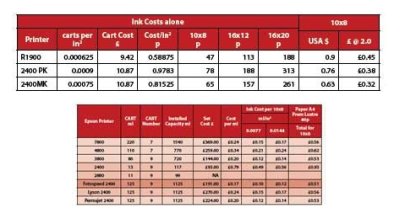articles/Business/teneight-page1
How much do you charge for a ten-eight? - part 1 of 1 2 3 4 5
by Mike McNamee Published 01/08/2008

How much do you charge for a ten-eight?
Mike McNamee turns the perennial question on its head and asks
"How much does a ten-eight cost?" before going off on one at the Post Office - big time!
When posed by an innocent newbie at a social photography seminar this question usually brings on guffaws of derision. Such is the history of the question that the mischievous delegate has been known to pose the question, with feigned ignorance, simply to spice up a flagging Q & A session!
A posting on a forum, linking to Red River paper in the USA (http://www.redrivercatalog.com/cost-of-inkjet-printing-v1.html) started this whole thing off, but we needed to turn it on its head and ask how much does a 10x8 print cost to produce? The Red River link works in US dollars so we factored the data into sterling and did a check sum as well. Then we set about comparing our own previous data as well.
On the face of it, it should be easy to calculate the cost of a 10x8 from an inkjet. Add the cost of the cartridges and divide by the number of 10x8s you will get out of that cartridge set. Then the trouble begins for a raft of reasons:
1. How many inks are actually used (you never use both Matt Black and Photo Black at the same time and you may or may not use Gloss Optimiser at all on some printers)?
2. How much ink is left behind when you remove a cartridge?
3. How much ink is used in the periodic 'cleaning cycles' carried out by an idle printer?
4. What is a standard print and how much ink does it take?
5. At what rate are the inks used up - this is image dependent.
6. Generally people take no account of the cost of replacing the maintenance tank
After some deliberation we dropped the Epson 1900 from our own calculations. It uses Gloss Optimiser at about twice the rate that the other cartridges use ink. However, each time a GLOP is changed it brings on a flushing cycle so the GLOP is a heavier contributor to wastage.
Using the LFP utility of the large format Epsons gives us a detailed breakdown of ink utilisation. We have previously used this data to calculate the rough boundaries of ink usage in millilitres for a square inch of print. This is a tiny figure with lots of zeros so a measure of 'ink per A2 print' is easier to grasp. The value varies from 1.35ml to 2.26ml, a 40% variation on image make-up alone. Our previous calculations resulted in ball-park figures of 0.5p/in2 for 110ml, Epson 4800 cartridges and 0.375p/in2 for 220ml, Epson 7800 cartridges. These remain reasonably accurate.800 cartridges and 0.375p/in2 for 220ml, Epson 7800 cartridges. These remain reasonably accurate.
Our calculations indicate that the paper is the most significant component of cost and sadly it is not even available in 10x8 sheets! However, we understand that Fotospeed are giving thought to making it available. The calculations indicate that the type of image (eg monochrome, full-inked graphics colours, portraits) has only a minor influence on cost. The greatest ink-use reduction would be a very high-key print with a large border, for which you could probably take out the ink cost altogether and not even notice!
You are currently on page 1
- How much do you charge for a ten-eight? page 1
- How much do you charge for a ten-eight? page 2
- How much do you charge for a ten-eight? page 3
- How much do you charge for a ten-eight? page 4
- How much do you charge for a ten-eight? page 5
1st Published 01/08/2008
last update 09/12/2022 14:59:35
More Business Articles
There are 0 days to get ready for The Society of Photographers Convention and Trade Show at The Novotel London West, Hammersmith ...
which starts on Wednesday 15th January 2025





